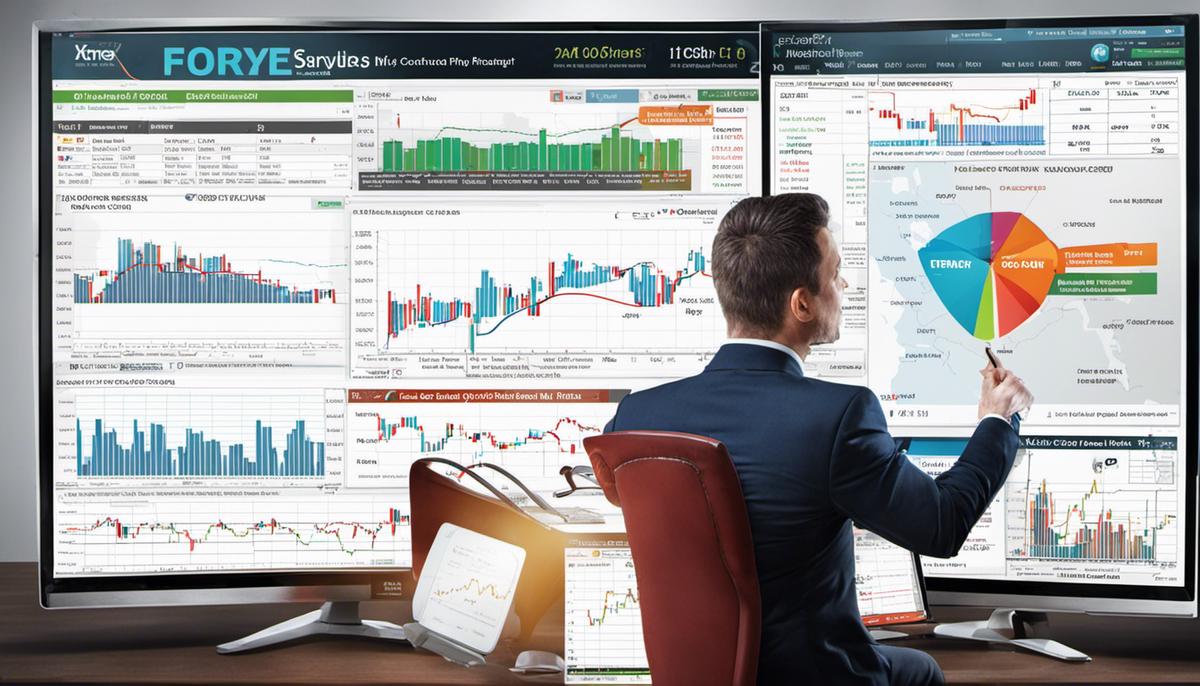Risk management takes center stage in forex trading, a volatile and complex financial market. As a prospective trader or investor, having a firm grasp on the potential risks and how to mitigate them may provide an indispensable edge in navigating the intricate landscape of forex trading. This paper sheds light on what these risks are, examines their nature, and provides a holistic guide on how to manage them effectively. It further delves into the psychology of trading, exploring the role of emotional control in risk management. The concepts of stop-loss and take-profit orders, lot size determination, and leverage usage highlight the fundamentals of risk management. Made explicit are the influence of tools and resources that complement sound risk management strategies to fortify one’s trading performance.
Understanding Forex Trading Risks
Understanding the Inherent Risks in Forex Trading
Forex trading, also known as foreign exchange or currency trading, refers to the buying and selling of currencies in the foreign exchange market. These trades can involve substantial risks, which is why understanding and effectively managing these risks is crucial for any successful forex trader.
Market Risk
One of the significant risks in forex trading is the market risk. Market risk is the potential loss that could occur from movements in market prices. Currencies are highly susceptible to various factors, including geopolitical events, changes in economic indicators, market sentiment, and other macroeconomic aspects. These elements can cause currency prices to fluctuate wildly, leading to potentially massive gains or losses.
Leverage Risk
Leverage risk is another essential factor to consider in forex trading. Leverage allows traders to operate with more money than they have in their account, potentially amplifying their profits. However, it also amplifies losses, meaning that traders can lose more than their initial investment. If not carefully managed, leverage can quickly lead to significant losses.
Interest Rate Risks
Interest rate risks arise from changes in the interest rates that central banks set. As interest rates rise or fall, they can significantly affect the value of a currency. For instance, when a country’s interest rates increase, it can cause an inflow of foreign investments, thereby raising the value of the country’s currency. Conversely, when interest rates fall, it can lead to an outflow of investments, thus decreasing the currency’s value.
Transaction Risks
Transaction risks refer to the potential losses that could occur due to time differences between the start and completion of a contract. Forex transactions often involve parties from different time zones, adding an element of uncertainty regarding currency value fluctuations during the period between transactions.
Liquidity Risks
Finally, liquidity risks can pose a significant problem in forex trading. Liquidity refers to how quickly assets can be bought or sold without affecting the asset’s price. The forex market is generally highly liquid because of its massive size and 24-hour operation. However, certain events may lead to reduced market liquidity, such as during economic or political crises. Such situations can make it difficult for traders to open or close positions at their desired prices.
The Role of Risk Management in Forex Trading
Understanding these risks lays the groundwork for effective risk management in forex trading. Risk management strategies are vital to protect traders from sizeable losses and ensure their long-term success in the forex market. These strategies can include setting stop-loss orders, limiting leverage, diversifying investments, and constantly staying informed about market conditions and trends.
In the world of investment, forex trading stands out for its potential to yield considerable profits. However, it isn’t devoid of risks, making it crucial to comprehend and appropriately manage these risks for success in forex trading.

Forex Trading Risk Management Fundamentals
The Essential Pillars of Risk Management in Forex Trading
Forex – an abbreviation for foreign exchange – is a market involving the exchange of different global currencies. The opportunities to earn considerable profits are high, yet the risks associated with forex trading aren’t to be ignored. This draws attention to the necessity of a well-crafted risk management strategy rooted in core principles.
One of the core principles of risk management in forex trading is the use of stop-loss and take-profit orders.
These orders allow traders to set predefined levels at which they want their trades to be automatically closed. A stop-loss order will close a trade when the market moves against the trader’s position, limiting potential losses. On the other hand, a take-profit order will close a trade when the market moves in favor of the trader’s position, ensuring that they lock in their profits.
Lot Size Determination and Leverage Usage
Lot size determination is another fundamental principle of risk management in forex trading. The lot size refers to the number of units of the forex traded. Selecting the right lot size can be crucial in managing potential losses. A smaller lot size means lesser exposure to market fluctuations, while a larger lot size increases the risk.
Meanwhile, leverage is a tool that traders use to control large amounts of currency with relatively little capital. Leverage magnifies both profits and losses. Therefore, it’s imperative for traders to use leverage wisely. Over-leveraging often leads to substantial losses, so traders should use leverage in line with their risk tolerance.
Diversification in Forex Trading
Diversification is a fundamental principle of risk management across all forms of trading and investment, including forex trading. By putting their money in different currencies, traders can spread their risk. If one currency performs poorly, the loss may be offset by the good performance of another currency.
Diversification does not guarantee profits or fully protect against losses, but it can help reduce the impact of negative market movements. It’s important to note that diversification should be done wisely; over-diversification may lead to average returns and undermine the potential to earn significant profits.
Conclusion: The Crucial Role of Risk Management in Forex Trading
Risk management is a paramount aspect of forex trading, with a comprehensive understanding of its central principles providing a solid foundation for mitigating potential losses. These principles include implementing stop-loss and take-profit orders, accurately determining lot size, careful utilization of leverage, and strategically diversifying your portfolio. However, these factors alone don’t wholly encapsulate the elements of successful forex trading. Keeping this in mind, continuous self-education and awareness of market trends and activities play an equally important role.

Implementing Forex Trading Risk Management Techniques
Delving Deeper into the concept of Risk Management in Forex Trading
Risk management in foreign exchange trading doesn’t refer to a single defined strategy. Instead, it encapsulates a collection of concepts strategized to control and limit trading risks. Such a strategy can manifest as restricting your trade lot size, intelligent hedging, trading within certain hours or particular days, or understanding when to accept losses. While successful forex trading relies on scoring more profitable trades than unsuccessful ones, it doesn’t negate the fact that even successful traders occasionally lose. The key, therefore, isn’t avoiding losses altogether, but rather it lies in effective risk management – implementing a range of meticulously crafted strategies and techniques designed to safeguard trading capital from excessive risk.
Planning Before Trading
In forex trading, planning before you place your trade is crucial in the management of potential risks. This involves having a solid well-thought-out plan that should include your risk tolerance, goals, and the methodology or strategy you’ll use. The plan can act as your guidepost to navigate the volatile world of forex, both in profitable times and during downturns. Therefore, putting time and thought into your plan can save you from unnecessary losses and stress in the future.
The Role of Discipline in Implementing Strategies
Risk management is not only about strategies but also how you implement them. Many traders have sophisticated strategies, but when it comes to implementation, they falter due to a lack of discipline. Some may give in to emotions and overtrade or keep a losing position open in the hope of a turnaround. This level of discipline involves setting your risk limit and stick to it, and not being swayed by market fluctuations. Discipline is crucial in ensuring your risk management is not compromised.
Continuous Learning and Refining Techniques
The forex market is dynamic and continually evolving. As such, there is a need for continuous learning and refining trading strategies to adapt to these changes. It’s necessary to educate yourself on market trends, economic indicators, and new trading techniques. Implementing what you learn will, over time, lead to improved performance and risk management. Constantly refining your trading systems and strategies will keep you updated with the current trends and traps in the forex markets.
Effective Approaches to Forex Trading Risk Management
Risk management in forex trading is critical and can effectively be addressed by incorporating various strategies, such as:
- Implementing Stop Loss Orders: This type of order serves as a safety net, protecting you from extensive losses should the market take a wrong turn. You predetermine a level at which you are willing to close a losing position, thereby limiting your losses.
- Applying Take Profit Orders: This is a pre-set level where you are happy to lock in your profits before the market reverses course. Once this level is reached, trades are automatically closed.
- Practicing Position Sizing: This involves deciding what amount of your portfolio you are willing to risk on a single trade. Often, traders follow a general rule of risking only 1-2% of their total funds on a single venture.
- Diversifying Investments: Diversification isn’t merely trading various forex pairs. It also includes maintaining other investments besides forex to counterbalance any potential forex trading losses.
- Maintaining Emotional Stability: Keeping emotions in check is integral to successful risk management, as strong feelings can lead to irrational decisions.
Utilizing these strategies can protect you against unpredictable market changes. However, it’s essential to remember that risk management is an ongoing process that needs constant revision and adjustment according to both market conditions and your performance.

Impact of Emotional Control on Forex Trading Risk Management
The Role of Emotion in Forex Trading Risk Management
Emotional intelligence is a significant component of risk management in forex trading. Traders’ emotional reactions to gains and losses can have drastic effects on their decision-making processes, often leading to risky behaviors and subsequent financial losses.
Fear, a commonly encountered emotion in forex trading, can prompt a trader to close a position prematurely at the slightest hint of a market downfall. This reaction potentially eliminates the chance for a later rebound. Furthermore, the same fear can trigger aggressive trading to recoup losses, leading to poor decisions that amplify risks.
Greed, another strong emotion, can drive traders to make impulsive and perilous trades. An excessively greedy trader may ignore impending risks and hold onto a position longer than advisable in hopes of a large payoff. This behavior can lead not only to substantial losses but also to a harmful gambling-like mindset, detrimental to sound forex trading risk management.
Excessive excitement, often a result of successful trades, can likewise interfere with reasonable risk management in forex trading. The rush of excitement, similar to greed, can cause traders to neglect evident risks and venture into reckless trades.
Importance of Emotional Control in Forex Trading Risk Management
Maintaining emotional control in forex trading is paramount. Emotional control allows traders to keep a clear and objective mind amidst market volatility, thus enabling them to make well-informed decisions based on market trends and not on passing emotions. This ability helps traders avoid costly errors linked to fear, greed, or overexcitement.
Gaining Emotional Equilibrium in Forex Trading
Gaining emotional equilibrium in forex trading requires a blend of several factors. Initially, traders need to develop a systematic and data-driven approach towards their trading. This implies gaining a solid understanding of historical market movements, current market trajectories, and possible future patterns. It’s more sensible to base trade decisions on these factual details rather than mere instincts.
Additionally, prudent forex trading risk management requires the establishment of realistic, comprehensible, and achievable trading objectives. By setting and strictly adhering to these targets, forex traders can avoid putting excessive emotional and financial investment into individual trades, hence maintaining a balanced and lucrative portfolio.
Exercising patience and discipline forms a core part of emotional management. As forex trading is a marathon, not a sprint, it requires an acceptance of potential losses alongside gains. By remaining patient and disciplined, traders can bide their time for economically viable opportunities and steer clear of hasty and emotionally-charged decisions.
Furthermore, consistent self-analysis and continual learning play significant roles in mastering emotional control. By frequently evaluating their emotional reactions during the trading process, traders can identify and address their emotional triggers. In addition, a steadfast devotion to continued learning ensures traders remain updated with the latest risk management techniques, strategies, and tools in the forex industry.
Such elements collectively set the path towards a harmonized and emotionally stable trading mindset, a fundamental requirement for successful, long-lasting forex trading risk management.

Tools and Resources for Effective Forex Trading Risk Management
Capitalizing on Automated Trading Systems
Automated trading software functions as an invaluable tool in managing risks in forex trading. It enables traders to carry out trading operations systematically, as per pre-determined strategies and algorithms. Traders can specify exact criteria for entering and exiting trades. The software promptly executes trades when these criteria are met. Thus, trading becomes less impacted by emotions, thereby reducing risks related to human fallibility or psychological influences. Additionally, the speed and accuracy of automated software surpass that of manual trading, capable of handling a larger volume of trades. This capability allows for better diversification of trades and enhances overall risk management efficiency.
Trade Simulators
Trade simulators are indispensable for both novice and experienced forex traders. They provide a platform where traders can practice trading strategies without the risk of losing real money. This tool allows traders to gain experience and confidence, understand how various strategies work under different market conditions, and learn how to manage risk effectively.
Technical and Fundamental Analysis
Technical and fundamental analysis are essential for risk management in forex trading. Technical analysis involves studying past market data, primarily price and volume, to predict future market behavior. It encompasses various chart patterns, indicators, and statistical analyses to identify trading opportunities and manage risks.
On the other hand, fundamental analysis involves evaluating a country’s economic indicators, such as Gross Domestic Product (GDP), inflation rates, and unemployment rates to predict the future movement of its currency. Both analyses help traders make informed trading decisions, hence mitigating trading risks.
Risk Management Strategies
Risk management strategies are essential for successful forex trading, and the use of the mentioned tools can greatly aid in their implementation. Stop-loss orders, for example, can be incorporated into automated trading systems to automatically close positions once the market moves past a certain level, thus containing losses and minimizing risk exposure.
Likewise, the use of trade simulators can support the use of other risk management strategies such as position sizing, where traders limit the size of their trades to only a small percentage of their trading capital, minimizing potential losses.
Risk/Reward Ratio
The risk/reward ratio is another important tool in forex risk management. This ratio indicates the potential reward for every dollar risked. A high ratio means more potential profit for a smaller risk. Traders can use this ratio to set their stop-loss and take-profit levels, ensuring they do not risk more than they stand to gain. Automated software can significantly help in setting and adhering to these pre-determined levels.
Economic Calendar
Finally, an economic calendar is a necessary resource for any forex trader. It lists all significant economic events, including central banks’ decisions and economic indicators releases. These factors greatly affect currency prices, thus requiring regular monitoring by traders. Such calendars assist traders in planning their trades in advance, adjusting their strategies based on upcoming events, and managing risks associated with market volatility during such events.

Forex trading is not a venture for the faint-hearted. It requires strategic financial acumen, continuous learning, and a sound understanding of its inherent risks. Balancing the scales between fear and greed, staying disciplined in the application, and refinement of strategies are key to successful risk management. Moreover, utilizing the correct tools and incessantly elevating one’s knowledge on the latest strategies also shore up trading outcomes. The journey in forex trading can be volatile and filled with uncertainty, but armed with knowledge around risks and their management, they become less daunting, propelling market success. After all, a well-managed risk not only protects potential losses but births the opportunity for substantial financial gains.